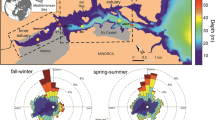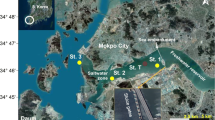Abstract
This review of the preceding papers suggests that temporal variability in San Francisco Bay can be characterized by four time scales (hours, days-weeks, months, years) and associated with at least four mechanisms (variations in freshwater inflow, tides, wind, and exchange with coastal waters). The best understood component of temporal variability is the annual cycle, which is most obviously influenced by seasonal variations in freshwater inflow. The winter season of high river discharge is characterized by: large-scale redistribution of the salinity field (e.g. the upper estuary becomes a riverine system); enhanced density stratification and gravitational circulation with shortened residence times in the bay; decreased tissue concentrations of some contaminants (e.g. copper) in resident bivalves; increased estuarine inputs of river-borne materials such as dissolved inorganic nutrients (N, P, Si), suspended sediments, and humic materials; radical redistributions of pelagic organisms such as copepods and fish; low phutoplankton biomass and primary productivity in the upper estuary; and elimination of freshwater-intolerant species of macroalgae and benthic infauna from the upper estuary. Other mechanisms modulate this river-driven annual cycle: (1) wind speed is highly seasonal (strongest in summer) and causes seasonal variations in atmosphere-water column exchange of dissolved gases, resuspension, and the texture of surficial sediments; (2) seasonal variations in the coastal ocean (e.g. the spring-summer upwelling season) influence species composition of plankton and nutrient concentrations that are advected into the bay; and (3) the annual temperature cycle influences a few selected features (e.g. production and hatching of copepod resting eggs). Much of the interannual variability in San Francisco Bay is also correlated with freshwater inflow: wet years with persistently high river discharge are characterized by persistent winter-type conditions.
Mechanisms of short-term variability are not as well understood, although some responses to storm events (pulses in residual currents from wind forcing, erosion of surficial sediments by wind waves, redistribution of fish populations) and the neap-spring tidal cycle (enhanced salinity stratification, gravitational circulation, and phytoplankton biomass during neap tides) have been quantified. In addition to these somewhat predictable features of variability are (1) largely unexplained episodic events (e.g. anomalous blooms of drift macroalgae), and (2) long-term trends directly attributable to human activities (e.g. introduction of exotic species that become permanent members of the biota).
Similar content being viewed by others
References
Ambler, J. W., J. E. Cloern & A. Hutchinson, 1985. Seasonal cycles of zooplankton from San Francisco Bay. Hydrobiologia (this volume).
Armor, C. & P. L. Herrgesell, 1985. Distribution and abundance of fishes in the San Francisco Bay estuary between 1980 and 1982. Hydrobiologia (this volume).
Cloern, J. E., B. E. Cole, R. L. J. Wong & A. E. Alpine, 1985. Temporal dynamics of estuarine phytoplankton: a case study of San Francisco Bay. Hydrobiologia (this volume).
Conomos, T. J., R. E. Smith & J. W. Gartner, 1985. Environmental setting of San Francisco Bay. Hydrobiologia (this volume).
Hammond, D. E., C. Fuller, D. Harmon, B. Hartman, M. Korosec, L. G. Miller, R. Rea, S. Warren, W. Berelson & S. Hager, 1985. Benthic fluxes in San Francisco Bay. Hydrobiologia (this volume).
Hartman, B. & D. E. Hammond, 1985. Gas exchange in San Francisco Bay. Hydrobiologia (this volume).
Hatfield, S., 1985. Seasonal and interannual variation in the distribution and abundance of the shrimp Crangon franciscorum in San Francisco Bay. Hydrobiologia (this volume).
Josselyn, M. N. & J. A. West, 1985. The distribution and temporal dynamics of the estuarine macroalgal community of San Francisco Bay. Hydrobiologia (this volume).
Luoma, S. N., D. J. Cain & C. Johansson, 1985. Temporal fluctuations of silver, copper and zinc in the bivalve Macoma balthica in South San Francisco Bay. Hydrobiologia (this volume).
Nichols, F. H. & J. K. Thompson, 1985. Time scales of change in the San Francisco Bay benthos. Hydrobiologia (this volume).
Peterson, D. H., R. E. Smith, S. W. Hager, D. D. Harmon, R. Herndon & L. E. Schemel, 1985. Interannual variability in dissolved inorganic nutrients in Northern San Francisco Bay. Hydrobiologia (this volume).
Thomson-Becker, E. A. & S. N. Luoma, 1985. Temporal fluctuations in grain size, organic materials and iron concentrations in intertidal surface sediment of San Francisco Bay. Hydrobiologia (this volume).
Walters, R. A., R. T. Cheng & T. J. Conomos, 1985. Time scales of circulation and mixing processes of San Francisco Bay waters. Hydrobiologia (this volume).
Author information
Authors and Affiliations
Rights and permissions
About this article
Cite this article
Cloern, J.E., Nichols, F.H. Time scales and mechanisms of estuarine variability, a synthesis from studies of San Francisco Bay. Hydrobiologia 129, 229–237 (1985). https://doi.org/10.1007/BF00048697
Issue Date:
DOI: https://doi.org/10.1007/BF00048697




